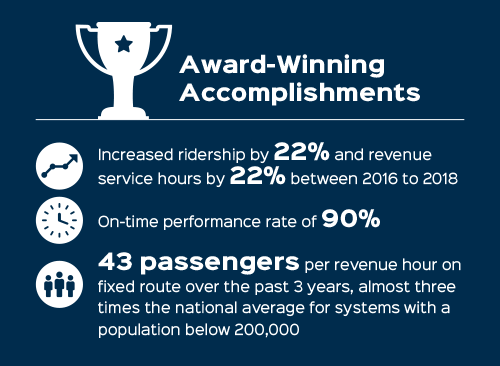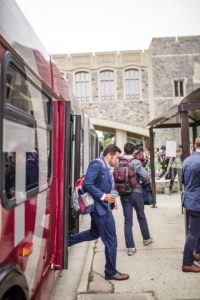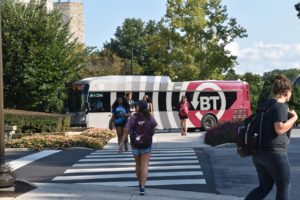
Contributed by TripSpark staff

Long-time TripSpark partner Blacksburg Transit (BT) won the American Public Transportation Association’s 2019 Outstanding Transit System award for North America, in the small urban system category. Tim Witten, ITS and Special Projects Manager for BT talks about how Big Data has helped improve customer experience, planning and service.
What TripSpark products do you use?
BT was an early adopter of TripSpark’s fixed route software, Streets, and mobile data terminals. They developed their own passenger information app and GTFS tools in-house, before they were readily available on the market.

Access to data unlocks strategic service improvements
The most important thing for Witten and his team was that TripSpark’s solution allowed complete access to their data and enabled them to develop their own reports.
Some agencies are not able to get access to that level of data, let alone be able to process it, he said. BT collects data at a granular level (11,000 data points a day), and pulls it back into their system to run more complex analysis.
“Many programs just do canned reports,” he said. “Our ability to be able to report ridership increases and to analyze at the stop-level is very important to us.”

Because of this, BT can analyze fare type, schedule adherence, first/last trips, passenger loads and trends, passenger revenue numbers, boarding/alighting, and compare off-campus and on-campus trips. In the short term, this provides invaluable insight into when headways should be changed, what stops can be eliminated or consolidated, and where the bus is being delayed, thereby improving schedule adherence. In the longer term it informs strategic decisions about new routes and increases or decreases in service on a system level.

“Data analysis is integrated into every decision we make. At many places data is separate. The most gratifying thing is that management comes to my team for data before they make decisions and I’m involved in the planning process” Witten said.
Answers to questions yet unasked
 Witten is an advocate for collecting as much data as possible for two reasons. The first is “so that I can ask questions that I’m not aware of yet,” he said. The traditional transit database is built around tracking passengers but doesn’t provide the ability to see what happened at a specific place and time, he said. Traditional databases are good for answering a specific set of questions.
Witten is an advocate for collecting as much data as possible for two reasons. The first is “so that I can ask questions that I’m not aware of yet,” he said. The traditional transit database is built around tracking passengers but doesn’t provide the ability to see what happened at a specific place and time, he said. Traditional databases are good for answering a specific set of questions.
As a university-oriented transit system, BT’s riders are very dynamic and their location changes frequently. BT must compare annual service levels on a week by week basis to get an accurate assessment.
The second reason for collecting all this information is to provide accurate predicted bus arrival times for passengers. Service varies day to day to accommodate daily changing class times, with mini rush hours between classes. Therefore, predicted arrival times for a particular stop on a particular day will be different from the following day or even week. To accomplish this “you need to have a lot of good data on a trip-by-trip, day-by-day basis,” Witten said.
Improving customer service and sussing out the full story
Big data also helps BT improve customer service and provide explanations for customer complaints.
“Are you going to be able to depend on a story or the truth? If you don’t have data, you have to rely on ‘I think,’ or ‘I heard’. Now we can say ‘This is really happening,'” Witten said.
For example, customer service may receive a complaint about a pass-by when a bus is full. Administrators would check to see if there were recorded pass-bys at the reported stop. For BT, one question often leads to another. The administrator would then dig deeper to see if there were more pass-bys reported in the last several weeks than the last few years, to see if there was a trend emerging.
Witten said they once ran an on-time performance report and saw there were a lot of early departures because one driver was leaving his last post four minutes early. “I took it to the operations manager and it was a coaching opportunity. We are able to understand why things are happening,” he said.
Big Data paves the way for BT to go digital
 95% of BT users have mobile devices, according to their last ridership survey. Digitally savvy riders galvanized BT to invest in a texting service and real-time bus map.
95% of BT users have mobile devices, according to their last ridership survey. Digitally savvy riders galvanized BT to invest in a texting service and real-time bus map.
“We’ve been ahead of the curve in giving our customers what they want. We haven’t had printed timetables in over six years. Everything is in our app or on our website,” Witten said. “Our customers know where to get the data.”
A passenger information system allows BT to make changes to their schedule without reprinting.
Riders can text their stop number and receive a text back with routes servicing that stop and times. So far this year, they have received an average of 2,500 text inquiries a day verses only 30 to 40 voice calls a day.
For Witten, the transit rider of the next 10 years expects to manage most of their daily responsibilities through their mobile device. Transit is heading down a new path with data and digitization.
TripSpark’s people transportation technology provides mid-sized transit agencies and private operators with the critical operational software and in-vehicle hardware they need to run efficiently and provide outstanding service to their customers. Our products form an integrated ecosystem, which includes the modern passenger information systems that customers demand and rely on today. Our technology suite serves Fixed Route, Paratransit, NEMT, Rideshare, and K-12 transportation. We pride ourselves in Moving Together with our customers as their needs change and offering the latest and greatest in modern people transportation technology.
